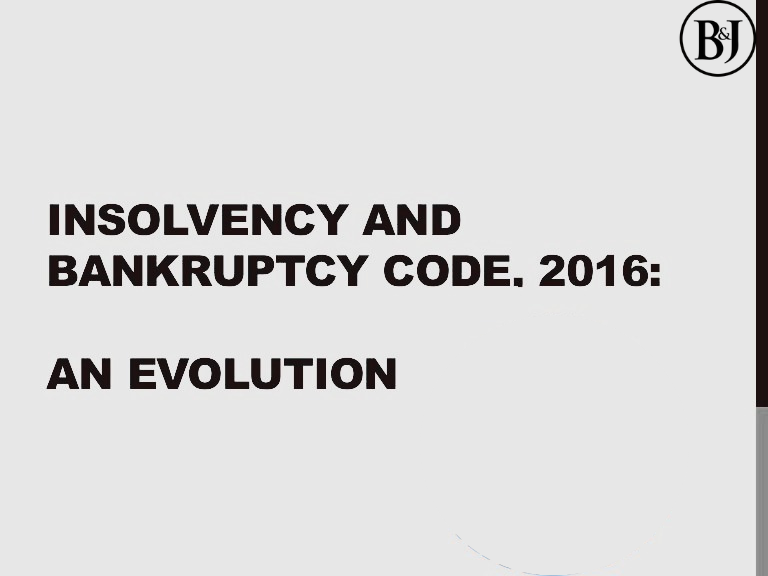Insolvency & Bankruptcy Code – IBC

The Insolvency and Bankruptcy Code, 2016 (‘IBC’) is the newly enacted bankruptcy law of India which seeks to consolidate the existing framework for debt recovery by creating a single law for insolvency and bankruptcy. The Insolvency and Bankruptcy Code, 2015 was introduced in Lok Sabha in December 2015. It became effective in December 2016. It is a one stop solution for resolving insolvencies which is a long process and does not offer an economically viable arrangement. It provides a strong insolvency framework where the cost and time incurred is minimized in attaining liquidation. The code strives to protect the interests of investors and make the process of doing business an efficient and easy task. It was framed with the intention to expedite & simplify the process of Insolvency and Bankruptcy proceedings in India, ensuring fair negotiations between Debtor and Creditor by removing the asymmetry of debt and default information
HISTORY
Before IBC could come into effect, the act which was working was the SICA( Sick Industrial Company). The fundamental goal of SICA is to decide disorder and facilitate the recovery of potentially practical units or conclusion of unviable (Units in this refers to a Sick Industrial Company). The SICA, 1985 was established with the end goal of getting the opportune discovery of sick companies which may have industrial undertakings. The major constraint of the SICA was that it was applicable only to sick industrial companies keeping away other companies which are in trading, service or other activities. However, it had drawbacks and one of those was it’s non-applicability to non-industrial companies and small/ancillary companies. In view of this, the Insolvency and Bankruptcy Code, 2016 was notified on May 28, 2016. The Companies Act, 1956 provided a process for the liquidation and winding up of all types of corporate entities.
Between early 2000’s and 2008 Indian economy was in the boom phase. During this period banks especially public sector banks lent extensively to corporates. However, because of the slowdown in the global economy, profits of various organizations swindled away. This in turn negatively impacted the ability of these companies to pay back their loans.
The bad loan recovery mechanism was governed by the following legislations prior to the enactment of Insolvency and Bankruptcy Code, 2016 (IBC).
-
SARFAESI Act, 2002
-
The Presidency Towns Insolvency Act, 1909 and The Provincial Insolvency Act, 1920
-
Companies Act, 2013
-
The Recovery of Debts due to Banks and Financial Institutions Act, 1993
-
The Sick Industrial Companies (Special Provisions) Act, 1985
-
CDR/SDR/S4A.
RECENT DEVELOPMENTS
The Insolvency and Bankruptcy Code, 2015 was introduced in Lok Sabha in December 2015. It became effective in December 2016. A Notification of national company law tribunal under SICA (special provisions) repeal act 2003 was passed Therefore, the SICA is repealed with effect from 1 December 2016. Because of this the Government notified that all the proceedings pending before the BIFR and AAIFR shall stand abated and will come to an end. However, it shall be open to the company whose appeal, reference or inquiry has abated to initiate fresh proceedings before the National Company Law Tribunal (NCLT). In accordance with the provision of insolvency code, within 180 days of the commencement of the insolvency code and to get the protection under section 14 of IBC 2016.
The four pillars of supporting institutional infrastructure, to make the Insolvency and Bankruptcy Process work efficiently are:
- The regulator – The Insolvency and Bankruptcy Board of India (IBBI)
- Adjudicating Authority (AA): It consists of National Company Law Tribunal (NCLT), National Company Law Appellate Tribunal (NCLAT), Debt Recovery Tribunal (DRT)
- A private industry of Insolvency Professionals (IPs) with oversight by private Insolvency Professional Agencies (IPAs)
- A private industry of Information Utilities (Ius)
Corporate Insolvency Resolution Process can only be initiated when the minimum amount of default rupees is one lakh or such higher amount as may be notified by the Central Government which shall not exceed one crore rupees. Further, Financial Creditor, Operational Creditor and the Corporate Debtor can initiate the Corporate Insolvency Process. Any creditor of the corporate debtor or the corporate debtor itself may file an application for insolvency resolution under the IBC. The trigger for filing an application is the occurrence of a payment default (defined as non-payment of a debt on its due date) of an amount of not less than INR 1,00,000. In the case of individuals and partnership firms, the minimum default amount is limited to INR 1,000. In the case of financial debt, a financial creditor, such as a bank, a non-banking financial institution or a debenture trustee, may file an application immediately upon a default occurring, provided that the information on the default is available in the records of an information utility or the applicant provides some other acceptable proof of non-payment. The Insolvency and Bankruptcy Code (Amendment) Act, 2019 was introduced to further strengthen the objectives of the Code. This amendment provides for the timely conclusion of cases, specifies minimum pay-outs to operational creditors in any resolution plan. The Insolvency and Bankruptcy (Insolvency and Liquidation Proceedings of Financial Service Providers and Application to Adjudicating Authority) Rules, 2019 were issued on November 15, 2019, which provide a generic framework for insolvency and liquidation proceedings of Financial Service Providers. Further amendments were made to the Code by way of the Insolvency and Bankruptcy Amendment Ordinance, 2019 passed on December 28, 2019
LANDMARK JUDGEMENTS
- Swiss Ribbons Pvt. Ltd. & Anr. vs. Union of India & Ors. IBC survived the test of constitutional validity, when the Supreme Court upheld IBC in its entirety in the case .It laid down the reasoning behind the differential treatment of financial creditors and operational creditors, clarified the role of a Resolution Professional who acts as the facilitator to the resolution process; and stated that IBC is not a mere recovery legislation for creditors but actually provides an opportunity for Corporate Debtor to be back on its feet.
- Essar Steel Limited case,– various Changes were made because of this judgement and some of them are that requirement of completing the corporate insolvency resolution process within 330 days from the insolvency commencement date as introduced by the 2019 Amendment Act was held as non-mandatory. Further, CoC can delegate its administrative powers or power of negotiation with the resolution applicants to a smaller committee.
- Pioneer Urban Land & Infrastructure Ltd. & Anr. vs. Union of India & Ors. The Supreme Court in this case upheld the constitutional validity of the introduction of homebuyers as “financial creditors” to the IBC, made by the Insolvency and Bankruptcy Code (Second Amendment) Act, 2018, enabling homebuyers to trigger IBC against the real estate developer.
- K. Sashidhar vs. Indian Overseas Bank. The Supreme Court in this case curtailed the jurisdiction of the Adjudicating Authority i.e. National Company Law Tribunal by observing that the NCLT has no jurisdiction and authority to analyse or evaluate the commercial decision of the Committee of Creditors.
- M/s Embassy Property Developments Pvt Ltd vs. State of Karnataka and Ors. The Supreme Court held that though NCLT and NCLAT would have jurisdiction to enquire into questions of fraud, they would not have jurisdiction to adjudicate upon disputes arising under other public laws
- Vijay Kumar Jain vs. Standard Chartered Bank & Ors. Apex Court held that the members of the suspended Board of Directors of a corporate debtor are vested with right to receive insolvency resolution plans submitted before the resolution professional
- Lokhandwala Kataria Construction Private Limited vs. Nisus Finance and Investment Managers LLP5. The Supreme Court in this case ruled that a settlement can be considered and a case can be withdrawn even after insolvency proceedings have started against a company on the merit of the case.
CONCLUSION
The Insolvency and Bankruptcy Code, 2016, is a reformist legislation that is intended to improve the efficiency of insolvency and bankruptcy proceedings in India. The new legislation provides for the early detection of financial distress and further it provides a time bound process for resolution. The Code’s adjusting through different supportive of dynamic revisions just as clarificatory decisions has end up being the straw that blends the beverage. Also, it can’t be rejected that this code has saved many sick and distressed companies from their premature death. The Code stays to be an invited change when contrasted with different systems of twisting up and BIFR, which used to take on a few events over many years to arrive at their decision. Insolvency proceeding under the code cannot be stayed or delayed by the debtors on flimsy grounds as the trend in the judgments is showing. The emphasis on the need for speedy resolution is being felt at NCLT as well as the higher level of judiciary.













